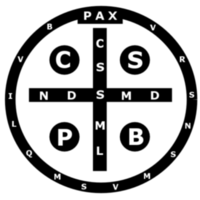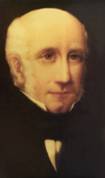
Vade retro satana
Encyclopedia

Middle Ages
The Middle Ages is a periodization of European history from the 5th century to the 15th century. The Middle Ages follows the fall of the Western Roman Empire in 476 and precedes the Early Modern Era. It is the middle period of a three-period division of Western history: Classic, Medieval and Modern...
Catholic
Catholicism
Catholicism is a broad term for the body of the Catholic faith, its theologies and doctrines, its liturgical, ethical, spiritual, and behavioral characteristics, as well as a religious people as a whole....
formula for exorcism
Exorcism
Exorcism is the religious practice of evicting demons or other spiritual entities from a person or place which they are believed to have possessed...
, recorded in a 1415 manuscript
Manuscript
A manuscript or handwrite is written information that has been manually created by someone or some people, such as a hand-written letter, as opposed to being printed or reproduced some other way...
found in the Benedictine
Benedictine
Benedictine refers to the spirituality and consecrated life in accordance with the Rule of St Benedict, written by Benedict of Nursia in the sixth century for the cenobitic communities he founded in central Italy. The most notable of these is Monte Cassino, the first monastery founded by Benedict...
Metten Abbey
Metten Abbey
Metten Abbey, or St. Michael's Abbey at Metten is a house of the Benedictine Order in Metten near Deggendorf, situated between the fringes of the Bavarian Forest and the valley of the Danube, in Bavaria in Germany.The abbey was founded in 766 by Gamelbert of Michaelsbuch...
in Bavaria
Bavaria
Bavaria, formally the Free State of Bavaria is a state of Germany, located in the southeast of Germany. With an area of , it is the largest state by area, forming almost 20% of the total land area of Germany...
and its origin is traditionally associated with the Benedictines.
In current Catholic tradition, the formula (sometimes reduced to the vade retro verse) is used to repel any possible evil
Evil
Evil is the violation of, or intent to violate, some moral code. Evil is usually seen as the dualistic opposite of good. Definitions of evil vary along with analysis of its root motive causes, however general actions commonly considered evil include: conscious and deliberate wrongdoing,...
thing or happening, as a "spoken amulet
Amulet
An amulet, similar to a talisman , is any object intended to bring good luck or protection to its owner.Potential amulets include gems, especially engraved gems, statues, coins, drawings, pendants, rings, plants and animals; even words said in certain occasions—for example: vade retro satana—, to...
". The initials of this formula (VRSNSMV SMQLIVB or VRS:NSMV:SMQL:IVB) have often been engraved around crucifix
Crucifix
A crucifix is an independent image of Jesus on the cross with a representation of Jesus' body, referred to in English as the corpus , as distinct from a cross with no body....
es or Catholic Saint Benedict Medal
Saint Benedict Medal
The Saint Benedict Medal is a Catholic sacramental medal containing symbols and text related to the life of Saint Benedict of Nursia. In use since at least the seventeenth century, it is used to ward off spiritual and physical dangers, especially those related to witchcraft, poison, and temptation...
s at least since 1780.
The phrase vade retro satana (often spelled vade retro satanas, or sathanas) is also used as a witty or scholarly prose device, dissociated from its religious implications, to express strong rejection of an unacceptable (but possibly tempting) proposal, or dread of some looming menace. Namely, in the sense of "do not tempt me!", "I will have nothing to do with that", "will someone deliver us from that", and so on.

Text
The Latin text says:- Crux sancta sit mihi lux / Non draco sit mihi dux
- Vade retro satana / Numquam suade mihi vana
- Sunt mala quae libas / Ipse venena bibas
In approximate translation:
- "Let the Holy Cross be my light / Let not the dragon be my guide
- Step back Satan / Never tempt me with vain things
- What you offer me is evil / You drink the poison yourself."
Origins and history
The verse Vade retro satana is similar to a phrase spoken by JesusJesus
Jesus of Nazareth , commonly referred to as Jesus Christ or simply as Jesus or Christ, is the central figure of Christianity...
to Peter
Saint Peter
Saint Peter or Simon Peter was an early Christian leader, who is featured prominently in the New Testament Gospels and the Acts of the Apostles. The son of John or of Jonah and from the village of Bethsaida in the province of Galilee, his brother Andrew was also an apostle...
in the Vulgate
Vulgate
The Vulgate is a late 4th-century Latin translation of the Bible. It was largely the work of St. Jerome, who was commissioned by Pope Damasus I in 382 to make a revision of the old Latin translations...
New Testament
New Testament
The New Testament is the second major division of the Christian biblical canon, the first such division being the much longer Old Testament....
, Gospel of Mark
Gospel of Mark
The Gospel According to Mark , commonly shortened to the Gospel of Mark or simply Mark, is the second book of the New Testament. This canonical account of the life of Jesus of Nazareth is one of the three synoptic gospels. It was thought to be an epitome, which accounts for its place as the second...
8:33: vade retro me, satana ("Get behind me, Satan!").

Witchcraft
Witchcraft, in historical, anthropological, religious, and mythological contexts, is the alleged use of supernatural or magical powers. A witch is a practitioner of witchcraft...
declared that they had been unable to do harm where there was a cross, and the St. Michael's Benedictine Abbey in Metten
Metten Abbey
Metten Abbey, or St. Michael's Abbey at Metten is a house of the Benedictine Order in Metten near Deggendorf, situated between the fringes of the Bavarian Forest and the valley of the Danube, in Bavaria in Germany.The abbey was founded in 766 by Gamelbert of Michaelsbuch...
was particularly exempt from their influence. A search of the monastery turned up crosses painted on the walls with the formula's initials. The meaning of those letters remained a mystery for some time, until the complete verses were found in a manuscript dating to 1415 in the abbey's library, next to an image of St. Benedict. The same formula was later found in an Austria
Austria
Austria , officially the Republic of Austria , is a landlocked country of roughly 8.4 million people in Central Europe. It is bordered by the Czech Republic and Germany to the north, Slovakia and Hungary to the east, Slovenia and Italy to the south, and Switzerland and Liechtenstein to the...
n manuscript from the 14th century.
Following its 1647 rediscovery, the formula was superstition, but after the formula was struck and sold on talisman
Amulet
An amulet, similar to a talisman , is any object intended to bring good luck or protection to its owner.Potential amulets include gems, especially engraved gems, statues, coins, drawings, pendants, rings, plants and animals; even words said in certain occasions—for example: vade retro satana—, to...
medals, it received the approval of Pope Benedict XIV
Pope Benedict XIV
Pope Benedict XIV , born Prospero Lorenzo Lambertini, was Pope from 17 August 1740 to 3 May 1758.-Life:...
, and became part of the Roman Catholic ritual
Roman Ritual
The Roman Ritual is one of the official ritual works of the Roman Rite of the Catholic Church. It contains all of the services which may be performed by a priest or deacon which are not contained within either the Missale Romanum or the Brevarium Romanum...
in 1742. The formula's popularity grew considerably in the 19th century, mainly due to the efforts of Leo Dupont
Leo Dupont
Venerable Leo Dupont , also known as "The Holy Man of Tours," or the "Apostle of the Holy Face", was a religious figure in the Roman Catholic faith who helped spread various Catholic devotions such as the devotion to the Holy Face of Jesus and nightly Eucharistic Adoration...
. According to H. C. Lea
Henry Charles Lea
Henry Charles Lea was an American historian, civic reformer, and political activist. Lea was born and lived in Philadelphia.-Parents:...
(1896), "As a rule...it suffices to wear
Glory Be to the Father
Gloria Patri, also known as Glory Be to the Father’ , is a doxology, a short hymn of praise to God in various Christian liturgies...
, three Aves
Hail Mary
The Angelic Salutation, Hail Mary, or Ave Maria is a traditional biblical Catholic prayer asking for the intercession of the Virgin Mary, the mother of Jesus. The Hail Mary is used within the Catholic Church, and it forms the basis of the Rosary...
and then three more Glorias to secure the protection of St. Benedict." The Vade Retro Satana remains part of the Roman Catholic ritual
Roman Ritual
The Roman Ritual is one of the official ritual works of the Roman Rite of the Catholic Church. It contains all of the services which may be performed by a priest or deacon which are not contained within either the Missale Romanum or the Brevarium Romanum...
following the 20th century revision of the ritual and its final promulgation in 1999 via De exorcismis et supplicationibus quibusdam.

